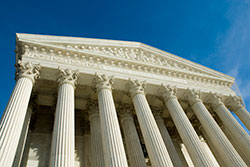 Two recent decisions by the U.S. Supreme Court have set a new precedent for future allegations of employment discrimination. According to USA Today, in a 5-4 decision, the Court ruled “that workplace discrimination can only be pinned on a supervisor who has the ability to hire and fire, rather than merely direct work assignments.” The New York Times expanded on this by highlighting the Court’s new definition of a supervisor as “someone authorized to take ‘tangible employment actions’ like hiring, firing, promoting, demoting, or reassigning employees to significantly different responsibilities.”
Two recent decisions by the U.S. Supreme Court have set a new precedent for future allegations of employment discrimination. According to USA Today, in a 5-4 decision, the Court ruled “that workplace discrimination can only be pinned on a supervisor who has the ability to hire and fire, rather than merely direct work assignments.” The New York Times expanded on this by highlighting the Court’s new definition of a supervisor as “someone authorized to take ‘tangible employment actions’ like hiring, firing, promoting, demoting, or reassigning employees to significantly different responsibilities.”
In another 5-4 decision, the Supreme Court sided with employers again when it came to illegal retaliation. As NPR explained, “the court said that those claiming to be the victims of illegal retaliation must show that the only reason for the action against them was that they reported some discriminatory action.”
These rulings mean from now on discrimination charges against co-workers or other employees will be looked at much more closely and compared against the Court’s new guidelines. And that has major implications for future lawsuits based on Title VII of the Civil Rights Act of 1964.
How This Could Affect You
As an employee, this ruling could impact you in several ways. If you believe you have suffered from workplace harassment or retaliation, it will now be more difficult to file suit for discrimination. It’s harder to file charges against your employer if the person harassing you is not a supervisor who fits the Court’s definition, even if that employee has truly been verbally or physically harassing you. And, even if you are able to move forward with a lawsuit, the required burden of proof will be much heavier, making it more difficult to win the case.
In regards to retaliation, if you do file, you must show that the retaliation was the determinative factor for the negative action.
The particular cases on which the Court ruled involved a lawsuit between Ball State University and a kitchen worker, and a suit between the University of Texas Southwestern Medical Center and a doctor. These were not easy cases for the justices. It took seven months of consideration before they reached their decisions, and even now, some are calling for the decisions to be over-turned.
